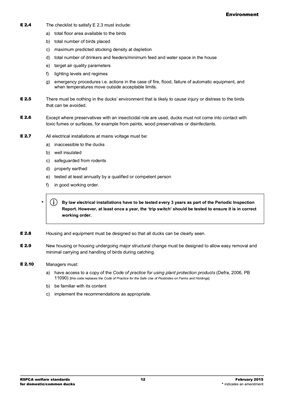
Environment
RSPCA welfare standards
for domestic/common ducks
12 February 2015
* indicates an amendment
E 2.4
The checklist to satisfy E 2.3 must include:
a) total floor area available to the birds
b) total number of birds placed
c) maximum predicted stocking density at depletion
d) total number of drinkers and feeders/minimum feed and water space in the house
e) target air quality parameters
f) lighting levels and regimes
g) emergency procedures i.e. actions in the case of fire, flood, failure of automatic equipment, and
when temperatures move outside acceptable limits.
E 2.5 There must be nothing in the ducks' environment that is likely to cause injury or distress to the birds
that can be avoided.
E 2.6 Except where preservatives with an insecticidal role are used, ducks must not come into contact with
toxic fumes or surfaces, for example from paints, wood preservatives or disinfectants.
E 2.7
All electrical installations at mains voltage must be:
a) inaccessible to the ducks
b) well insulated
c) safeguarded from rodents
d) properly earthed
e) tested at least annually by a qualified or competent person
f) in good working order.
*
By law electrical installations have to be tested every 3 years as part of the Periodic Inspection
Report. However, at least once a year, the 'trip switch' should be tested to ensure it is in correct
working order.
E 2.8 Housing and equipment must be designed so that all ducks can be clearly seen.
E 2.9 New housing or housing undergoing major structural change must be designed to allow easy removal and
minimal carrying and handling of birds during catching.
E 2.10 Managers must:
a) have access to a copy of the Code of practice for using plant protection products (Defra, 2006, PB
11090) [this code replaces the Code of Practice for the Safe Use of Pesticides on Farms and Holdings]
b) be familiar with its content
c) implement the recommendations as appropriate.